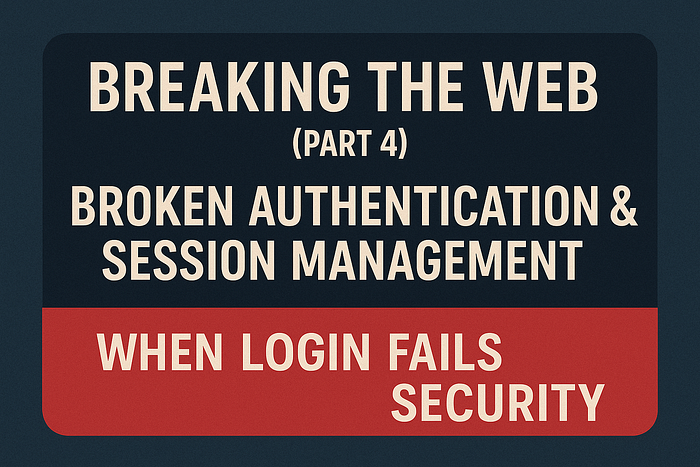Authentication is the gatekeeper of every web application. When it's weak or poorly implemented, attackers don't need to break in — they just walk through the front door.
In this chapter of Breaking the Web, we dive deep into Broken Authentication & Session Management, one of the most exploited vulnerabilities in the OWASP Top 10.
What Is Broken Authentication?
Broken authentication happens when attackers can compromise user credentials, session tokens, or authentication logic — allowing them to impersonate users or escalate privileges.
It's not just about weak passwords. It's about how the entire login flow, token management, and session lifecycle are handled.
Common Attack Scenarios
- Weak or Predictable Passwords
- No password complexity or length requirement.
- Reuse of default credentials (
admin/admin).
2. Credential Stuffing / Brute Force
- Attackers use automated tools to try leaked credentials from other breaches.
- Without rate-limiting or account lockout, success is just a matter of time.
3. Session Hijacking
- Stealing valid session tokens (through XSS, insecure transmission, or exposure in URLs).
4. Session Fixation
- Forcing a user to use a known session ID, then taking over after they log in.
5. Insecure Password Recovery Mechanisms
- Using predictable reset links or weak validation questions.
🧠 Real-World Example
A web app transmits session IDs in the URL like this:
https://example.com/dashboard?sessionid=12345If a user shares that link or it's logged by a proxy, the attacker can reuse the session ID and access their account — no password required.
🧩 Why It Happens
- Developers rely solely on passwords for protection.
- Session tokens aren't properly invalidated after logout.
- Authentication mechanisms are custom-built and poorly tested.
🛡️ How to Prevent Broken Authentication
- Use Strong Password Policies
- Enforce minimum length and complexity.
- Implement MFA (Multi-Factor Authentication).
2. Protect Session Tokens
- Use secure, random session IDs.
- Mark cookies as
HttpOnly,Secure, andSameSite. - Invalidate sessions on logout or inactivity.
3. Prevent Brute Force Attacks
- Add rate limiting and account lockout.
- Use CAPTCHAs where appropriate.
4. Secure Password Recovery
- Use cryptographically strong reset tokens.
- Expire tokens quickly and validate thoroughly.
💬 Final Thoughts
Authentication is your first line of defense — and often the first thing attackers go after. Even a small oversight in session handling or password logic can lead to a full account takeover.
In Part 5 of Breaking the Web, we'll explore Business Logic Flaws — vulnerabilities that hide in plain sight by exploiting how your application was meant to work.
Have you ever encountered weak authentication in a real app? What was the flaw? Share your insights below 👇
#cybersecurity #websecurity #infosec #authentication #sessionmanagement #breakingtheweb

